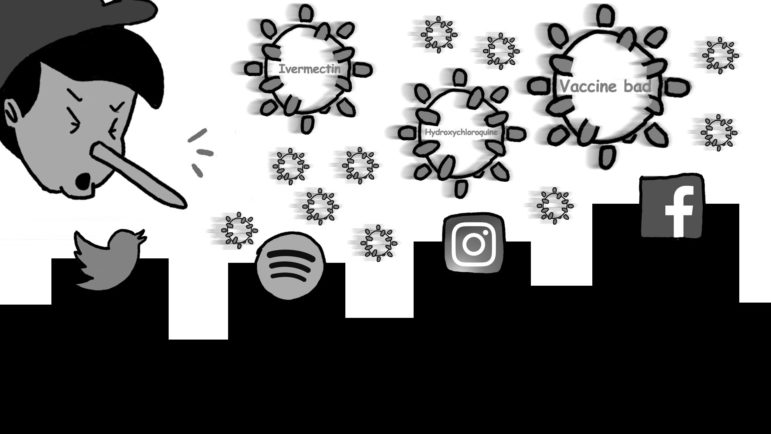

In August of 2021, the U.S. Food and Drug Administration tweeted, “You are not a horse. You are not a cow. Seriously, y’all. Stop it.” It was a response to the latest COVID-19 cure-all frenzy tearing through America: ivermectin. Spawning from the findings of a disproven lab test, ivermectin became the long-awaited remedy for COVID-19. Supplies of ivermectin ran out so quickly that people resorted to veterinary ivermectin, intended for deworming horses. But the trending topic soon became a public health concern. Calls to the Poison Control Center regarding ivermectin increased significantly and a couple died after deferring proper COVID-19 treatment in favor of ivermectin. However, ivermectin was only one of many viral trends in a sea of COVID-19 misinformation.
Exploiting the uncertainty of the pandemic, misinformation has become rampant. Even reliable sources have proven to give contradictory advice.
Social media has contributed to misinformation’s rapid spread. A study by the Pew Research Center showed nearly 70% of Americans get a portion of their news from social media.
“I think it’s so easy to just pull up your phone and be on Instagram or a different social media [site] quickly,” said math teacher Anton Moshkounian. “Sometimes, [people take] the first thing [they see] … for fact.”
In a time of social media, the line between reliable and unreliable sources can become blurred. Those with influence over millions of people do not have to be experts to get information across, creating echo chambers of baseless claims. Furthermore, people who rely on social media for their information do not always check it with background research.
“It sounds so dumb to them, because, ‘Why would we need to research anything when the information is there?’” said freshman Andrea Lazo Cruz. “If they’re following someone they trust, then they would trust the information so they don’t need to do extra research.”
A direct correlation exists between social media posts and real-world risk-taking. Hydroxychloroquine, a false cure for COVID-19, received notable positive attention, even from former President Donald Trump in official press briefings and tweets. In late March of 2021, there were over 100 thousand Facebook posts about hydroxychloroquine and thousands of tweets on the subject per hour. According to the Food and Drug Administration, prescriptions and hydroxychloroquine-related adverse events, including deaths and hospitalizations, rose to twice the normal levels and remained at record high levels for the first half of 2021.
The National Bureau of Economic Research published a study showing that areas exposed to misinformation about the severity of the pandemic had lower numbers of people following public health precautions and, in turn, higher case and death rates.
“Sometimes, [people take] the first thing [they see] … for fact”
Rumors of masks causing toxic carbon dioxide concentration or disbelief in COVID-19, while both disproven, drive some to resist mask mandates. Numerous studies, including those from the Centers for Disease Control and Prevention, show that mask mandates are linked to significantly lower COVID-19 case and death rates.
Similarly, the COVID-19 anti-vax movement is largely fueled by misinformation and conspiracy theories. While vaccine hesitancy may reflect legitimate health concerns, statistics prove that vaccines reduce hospitalizations and deaths due to COVID-19. The National Institutes of Health and the CDC affirm that misinformation is leading to vaccine hesitancy.
“We have a family friend who refuses to get vaccinated because all the misinformation says that you can’t get [COVID-19] twice [because] you have immunity,” said sophomore Hailey La Monte.
Social media sites are taking preventative measures. Twitter, Facebook, Instagram, Reddit and others now flag and remove potentially dangerous content.
Many believe that combating misinformation should include increasing awareness.
“If people are … shaming people for believing rumors … I don’t think [it’s effective],” Lazo Cruz said. “Instead, I think people should try and educate them about the misinformation.”
Others think that government organizations should be more active on social media.
“Social media is [a] common platform, so if there’s some way for the CDC to make a … connection with the social media platforms, maybe they can present their information through that,” Moshkounian said.
Twitter and Facebook both link professional fact-checking organizations and the CDC’s website next to misleading content. Out of a pandemic, a new phenomenon, coined an infodemic, has emerged.
“People want to go back to normal so if they see claims that align [with going back to normal], they’ll believe it no matter what, because they want it to be true,” La Monte said.
From conspiracy theories to misguided claims, COVID-19 misinformation has spread nearly as fast as COVID-19 itself.



